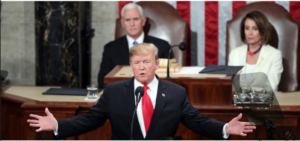
President Donald J. Trump P’00 delivered his second annual State of the Union address on February 5. Photo courtesy of Fox News
On February 5, President Donald Trump’s relatively tempered State of the Union Address surprised many. Veering away from his typically aggressive approach, President Trump called for a unified country and bipartisan support on certain issues, namely the threat of another government shutdown. Still, the speech proved to be largely contradictory and essentially useless in the face of numerous issues plaguing the nation.
Rather than seriously confronting problems and proposing legislative solutions, the State of the Union better resembled a campaign rally. President Trump appealed more to his political base instead of trying to establish better terms with Democrats, especially in the wake of his senseless government shutdown. He abandoned his initial plea for cooperation between Republicans and Democrats by once again exaggerating horrific details at the southern border for fourteen minutes, despite 2018’s illegal border crossings totaling to be less than the average over the previous decade according to the U.S. Customs and Border Patrol.
President Trump failed to propose a plausible compromise for his border wall, regardless of his declaration that “We can bridge old divisions, heal old wounds, build new coalitions, forge new solutions.” He seemingly shared the goals for unity to present an image that would reflect well on him, not one that he personally believes. President Trump’s vehement criticism of Virginia’s governor for supposedly vowing to “execute” newborn babies, as well as his dismissal of investigations into his administration’s connections to Russia as “ridiculous” and “partisan” only support the idea that President Trump refuses to embrace true bipartisanship.
President Trump’s speech conflicted with the actions he has taken during his presidency. While his own immigration bill called for halving legal admissions, he claimed during his speech, “I want people to come into our country, in the largest numbers ever, but they have to come in legally.” Similarly, President Trump proclaimed that “we must reject the politics of revenge, resistance, and retribution,” yet it is clear that President Trump himself regularly pursues such tactics. Just this week he insulted former Vice President Joe Biden, Representative Elizabeth Warren and Senate Minority Leader Chuck Schumer. At the same time, by insisting that “peace and legislation” do not go hand in hand with “war and investigation,” he denounced his earlier hope that America would govern united. Because he implied that such investigations threaten national health and prosperity while specifically targeting Nancy Pelosi’s caucus, it is clear that President Trump will not renounce these politics of rage.
While President Trump’s promises to lower the cost of prescription drugs and to restore American infrastructure were commendable, they were merely reiterated from his 2018 State of the Union speech — representing the reality that while he introduced many policy aims, he failed to recognize how they would be achieved. While claiming that his solutions shed light on “problems neglected by leaders of both parties over many decades,” President Trump neglected to address a number of the nation’s problems. Despite worsening damage on the planet as a result of greenhouse gas emissions, President Trump completely evaded the topic of climate change. Likewise, he made no mention of the rapidly rising national debt, which has in fact doubled in the past decade according to the U.S. Treasury. Stacey Abrams, delivering the Democratic response to the State of the Union, managed to confront these neglected issues, namely gun violence and climate change.
President Trump’s State of the Union only featured his constant boasting of his self-proclaimed achievements, empty calls for unity, failure to address numerous pressing issues, and an abundance of contradictions. Ultimately, it did nothing more than demonstrate that the current state of the union is fragmented and dysfunctional.




